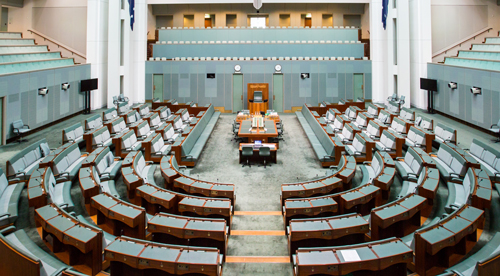Passing a Bill in Australian Parliament
After the analysis, research and consultation discussed in a previous article, Regulatory Impact Statement: an important tool in forming regulation, regulatory proposals that are considered feasible for legislation are required to go through another extensive process before they become law.
This article steps you through that process – how a Bill becomes an Act in Australian Federal Parliament.
The two Houses of Parliament
Australian Federal Parliament uses a bicameral system, meaning there are two Houses of Parliament – the House of Representatives and the Senate. Members of both Houses are responsible for the interests and concerns of Australians, making and passing new laws or amending existing ones, and scrutinising the work of the government.

The two types of Bills
Government public bills
The most common type of Bill introduced to Parliament are Government bills. They are introduced by a government minister, and are usually prepared because of instructions from Cabinet that legislation is required or from the minister’s department seeking approval of Cabinet.
Private senators’ and members’ public bills
Private senator and member bills are introduced by a senator or member of the House of Representatives or the Senate. As they are not government bills, their selection for consideration and debate in Parliament is determined by the government of the day.
Approval and initiation through Cabinet
The Cabinet is the main decision-making body of the government, consisting of senior Government Ministers, and most Bills require its approval before being introduced to Parliament. Upon approval the Bill is drafted by the Office of Parliamentary Counsel using the drafting instructions provided by the responsible Minister’s department. The department also prepares an explanatory memorandum – a plain English explanation of the Bill and its clauses for members of Parliament and the public.
A day prior to the Bill being introduced to Parliament, the minister or member responsible for the Bill will initiate the parliamentary process by giving a motion of notice of their intention to introduce a Bill. The motion needs to be agreed by the originating House before being introduced and read for the first time.

The Parliamentary process
Most Bills are introduced into the House of Representatives first, and then sent to the Senate. However, this order can change depending on the House the Bill was introduced. Regardless of the Bill’s origins, its journey to becoming an Act is the same.
The main stages of the process are:
| Stage | Description |
| First reading | A formal stage where the long title of the Bill is read by the Clerk. |
| Second reading | The minister or member responsible for the Bill performs a second reading speech, outlining the main principles and purpose of the Bill. Members of the house debate and vote on the main idea of the Bill.
Even though the debate is restricted to the principles of the Bill, it is not limited to the content.
Deliberation can also be on:
|
| Consideration in detail (House of Representatives)/Committee of the whole (Senate) | The Bill is considered in detail, this can be as scrupulous as clause by clause or schedule by schedule, and amendments are made. |
| Third reading | The Bill is reviewed in its final form, with any amendments made in the detail stage. Upon the third reading it has passed the House. |
| Passed to the second House for consideration | The Bill goes through the same process with members of the other House. |
| Royal Assent | Once the Bill has passed through both Houses, the Governor-General must assent on behalf of the Queen. The Bill then becomes an Act of Parliament. |

Deadlock between the Houses
If the two Houses do not agree on the Bill, the following can happen:
- Further amendments are negotiated by both Houses and made to the Bill.
- The Bill doesn’t go ahead at all.
- A double dissolution is triggered and a federal election of all members of both Houses takes place. After the double dissolution, the Bill is presented again and if there is still a disagreement, the Governor-General may order a joint sitting, whereby members from both Houses vote on the Bill together.
Having your say on proposed Bills
After a Bill is introduced to Parliament, it becomes a public document and is made available on the Parliament House website. It is also made available on the HSE Bulletin. Each month, you can view the environmental and safety Bills in progress and provide your feedback.

References
- Parliament of Australia webpage: About the House of Representatives
- Parliament of Australia webpage: Bills – The Parliamentary Process
- Parliament of Australia webpage: No. 8 – The Senate and Legislation
- Parliament of Australia webpage: The Passage of Private Members’ and Senators’ Bills through Parliament
- Parliament of Australia webpage: Work of the Parliament
- Parliamentary Education Office webpage: Double Dissolution
- Parliamentary Education Office webpage: Making a Law in the Australian Parliament
- Parliamentary Education Office webpage: The Usual Path of a Bill